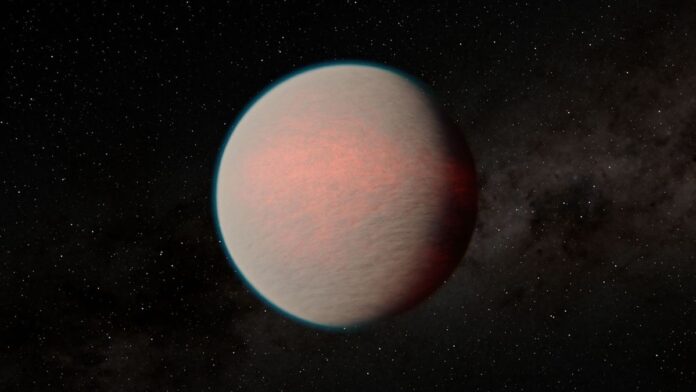The James Webb Space Telescope (JWST) has taken a deeper look at a mysterious planet outside the solar system that is unlike anything in our planetary system.
The extrasolar planet, or exoplanet, called Gliese 1214 b (GJ 1214 b), is an example of a “mini-Neptune,” a planet less massive than the solar system ice giant Neptune but still around two to four times the size of Earth. Despite being the most common type of planet found throughout the Milky Way, mini-Neptunes are curiously absent from our solar system. As a result, astronomers know little about these worlds. Likewise, Gliese 1214 b has proven difficult to observe due to its highly reflective atmosphere — until JWST turned its powerful gaze towards the alien world.
“The planet is totally blanketed by some sort of haze or cloud layer,” research lead author and University of Maryland exoplanet astronomer Eliza Kempton said in a statement. (opens in new tab) “The atmosphere just remained totally hidden from us until this observation.”
Kempton added that if GJ 1214 b indeed proves to possess a water-rich atmosphere, the exoplanet may have been a “water world” in its distant past, an exoplanet replete with large amounts of watery and icy material at the time of its formation.
Related: Exoplanets: Worlds Beyond Our Solar System
Unlike the icy planet that gives the category of planets to which GJ 1214 b belongs its name, this exoplanet found 48 light-years from Earth is scorching hot. As a result, astronomers do not expect to find liquid water oceans on GJ 1214 b, but believe that the planet’s atmosphere may still be composed of a large amount of water vapor. This thick, steamy envelope has helped this highly-reflective exoplanet maintain its aura of mystery.
The team used a novel combination of approaches to gaze through the thick atmospheric shell of GJ 1214 b as it orbits its red dwarf star parent star Gliese 1214, which it circles in just 1.6 Earth days.
GJ 1214 b is tidally locked, meaning it has a permanently star-facing “day side” and a perpetual “night side” that always stares out into space. Watching the planet as it disappeared behind its star and later emerged on the other side let astronomers see both its day and night sides and thus better detail its atmosphere.
“The ability to get a full orbit was really critical to understand how the planet distributes heat from the day side to the night side,” Kempton said. “There’s a lot of contrast between day and night. The night side is colder than the day side.”
Using the JWST’s Mid-Infrared Instrument (MIRI) that sees light from the infrared portion of the electromagnetic spectrum, just beyond wavelengths of visible light our eyes can see, the team created a “heat map” of GJ 1214 b as it orbited the star.
This showed that dayside temperatures on the planet are as great as 535 degrees Fahrenheit (279 degrees Celsius), while temperatures on the night side of GJ 1214 b drop to 326 degrees Fahrenheit (65 degrees Celsius).
This significant shift in temperature told the team that its atmosphere must be composed of heavier molecules, such as water or methane, rather than lighter hydrogen molecules. MIRI’s observations also backed this up, offering a clue regarding the formation of GJ 1214 b.
“This is not a primordial atmosphere,” Kempton said. “It does not reflect the composition of the host star it formed around. Instead, it either lost a lot of hydrogen, if it started with a hydrogen-rich atmosphere, or it was formed from heavier elements to begin with — more icy, water-rich material.”
One surprise that met the team when they studied GJ 1214 b with JWST was the fact that the mini-Neptune, despite being much hotter than a planet like Earth, is still much cooler than they expected. They think this relative coolness is because the exoplanet’s “shiny” atmosphere reflects a large amount of the light that falls on it from its parent red dwarf star.
The astronomers also found clues that GJ 1214 b may have formed further away from its star than its close orbit brings it currently. As it spiraled inwards, temperatures could have increased dramatically on the planet, boiling away ice and liquid water and creating a water vapor-filled atmosphere.
“The simplest explanation, if you find a very water-rich planet, is that it formed farther away from the host star,” Kempton said.
The team will now attempt to collect more data regarding GJ 1214 b to address some of the lingering questions about the planet. This may eventually allow astronomers to better understand how mini-Neptunes form and evolve. Observing a broader population of such exoplanets could even reveal why our solar system was deprived of such a world.
“By observing a whole population of objects like this, hopefully, we can build up a consistent story,” Kempton concluded.
An early version of the team’s research is published in the journal Nature. (opens in new tab)

